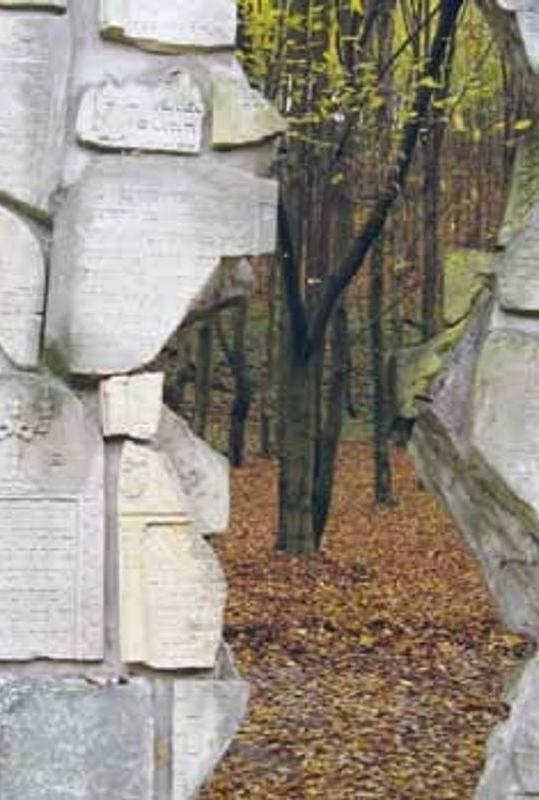
Kazimierz Dolny - New Jewish cemetery (Czerniawy St.)
Kazimierz Dolny - Nowy cmentarz żydowski (ul. Czerniawy)
New Cemetery (Czerniawy Street)- It was established in Kazimierz in 1851. ca. 1 km from the center, on the eastern slope of the ravine called Czerniawy, on the road leading towards Opole Lubelskie, on land donated to the municipality by Motek Hercberg. Originally founded on the plan of an elongated rectangle, it was located parallel to the road.The last burial known about; took place there in 1942. During World War II, like the old cemetery, it was almost completely devastated by the Germans.Some of the matzevot were used to pave streets in the city.Only a dozen or so tombstones have survived. The cemetery was the site of executions of Jewish and Christian people during the occupation, to this day the number of victims is unknown. After the war, its grounds were fenced off with a stone wall, which eroded and was eventually demolished in 1971. City authorities tried to sell the cemetery area for building plots, but found no buyer. In the first half of the 1980s, on the initiative of the Society for the Care of Monuments in Kazimierz, the Nadwiślański Museum and the Office for the Preservation of Monuments, work was undertaken on the partial reconstruction of the cemetery. It was then possible to collect dozens of matzevot from all over the city, some of which survived in fairly good condition. In 1985. From fragments of 600 Kazimier matzevot, as well as from tombstones from the Puławy cemetery, a monument-lapidarium in the form of a Wailing Wall was erected in Czerniawy, according to a design by Eng. Tadeusz Augustynk. Through a "crack" (gap) in the monument, symbolizing the tragic fate of Polish Jews during World War II, you can walk to the cemetery. In an unfenced area with illegible original boundaries and an area of 0.71 hectares, 25 tombstones dating to the second half of the 19th century have been set up. and the first forty years of the 20th century. The preserved matzevot with traces of polychromy, have high artistic value.On the hillside in front of the lapidarium about 50 matzevot were placed.Holocaust - In the spring of 1940. ca. The 2,000 Jews of Kazimier were resettled in a ghetto created in the area of the traditional Jewish neighborhood, i.e. Within the street. Lubelska Street and the Small Market. Jews from neighboring villages, as well as part of the Jewish community of Pulawy, were soon resettled in the ghetto. Since at least April 1940. The Committee for Relief of Refugees and Poor People, later transformed into the Delegation for Jewish Social Self-Help, operated at the local Judenrat. He made efforts to feed the poorest residents of the ghetto.In the fall of 1940, the Committee launched a kitchen serving 50-60 meals three times a week. In the spring of 1941. The authorities of the Lublin District decided to create a rest center for German soldiers and administrative staff in Kazimierz, so in March a complete resettlement of Jews to Opole Lublin was ordered. The implementation of the order was postponed, but Kazimierz had to leave about 200-300 Jews - mainly - immigrants. In June or July 1941. A second deportation was ordered, during which 300-500 people left Kazimierz.About 1000 Jews remained in the ghetto. The buildings of the former brewery on ul. At 50 Pulawska St. there was a labor camp established by the Germans, where Jews from Poland and the Czech Republic were housed, working in the nearby quarries and doing cleaning work in the settlement. The liquidation of the ghetto began in mid-March 1942. On March 25, the Jews were herded to the transition ghetto in Opole Lubelskie, and five days later - to the train station in Nałęczów. The liquidation of the remains of the Kazimierz ghetto, from which the last 500 residents were chased away to Nałęczów, continued in parallel. April 1, 1942. A transport of Jews from Kazimierz and Wąwolnica set out from the Nolczow train station to Belzec. Only those employed in the labor camp at the St. Pulawska Street, engaged in the demolition of the ghetto buildings.After the work was completed, the camp was liquidated, while the prisoners were taken away in an unknown direction. Among those who survived from the Kazimierz ghetto were. Berek Cytryn, who as Bronislaw Zieliński hid in Bochotnica, then in Warsaw.After the war, he emigrated to Switzerland. The war was also survived by residents of Kazimierz who took refuge outside the settlement, including. Jewish children rescued by Christian families, as mentioned in an account in the Casimir memory book (Pinkes Kuzmir, ed. D. Shtokfish, Tel Aviv 1970). There were also survivors of Kazimier Jews who were in the Soviet Union during the war.During the occupation, the Germans devastated Kazimier's cemeteries, and after the ghetto was liquidated, they destroyed community facilities and many Jewish homes.





